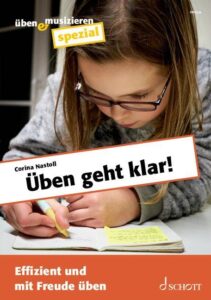Moments of happiness while practicing - but how?
Corina Nastoll suggests a variety of exercises and encourages self-directed learning so that there is no frustration when working on the instrument or with the voice.

"Practicing is a big, eternal, imaginative playground." Yes, music teacher Christoph Richter is right. Practicing your instrument or voice is an endless, sometimes difficult process. Continuity is particularly important. But easier said than done: time management is a problem for adults. For children, it is important to maintain the joy of playing so that they do not only enter the practice room after their parents' admonitions.
Corina Nastoll presents in the special issue of the magazine practicing & making music a comprehensive overview. It gives very specific tips on how to organize instrumental or singing lessons. Beautiful warm-up exercises are presented and various stimuli for intrinsic motivation are shown. And don't forget: Even the pupil who didn't get to practise can learn during lessons. Improvise something, for example, rhythmize a simple melody or practice sight-reading. This means that 40 to 60 minutes are not only quickly over, but also put to good use.
Practicing is a must! is fun. And that's also because Nastoll is not one to give up. As a trained music teacher, she knows the biggest mistakes of the past. She responds to the obsolete desire for perfection with a welcome culture of error, exaggerated stylistic fixations with flexible teaching, and finally, probably the most important thing: she advocates self-determination for the student: Where do I want to go? Which piece do I like? How much time do I want to take? What did I think of the last lesson?
The easy-to-read and beautifully designed booklet is certainly of great use to instrumental teachers. But parents or pupils should also take the time to read the 44 pages over two evenings. After reading it, you'll definitely want to sit down at the piano again and try out a few things. For example, the exercise called "owl", which loosens up and gets the blood flowing even before the practice session. Or the alternation of exercises to prevent monotony: learning two bars by heart, then playing a free chord, then perhaps continuing to work on the showpiece at the end.
With all the joyfully described tips and exercises, Nastoll manages en passant to create an awareness of the rewards of making and practicing music. Peter Röbke, quoted above, sums it up very impressively at the end of the booklet. According to the deserving music teacher, we get the following from effective learning: "Moments of happiness, immersion in the sound and real listening, dialog and devotion, absorption in self-forgetful playing, emotional breakthrough and creation, embodiment and physical being, almost spiritual experiences, as-if, transformations." Yes, if those aren't arguments!
Corina Nastoll: Practicing is easy! Practicing efficiently and with joy, 44 p., € 18.50, Schott, Mainz 2023, ISBN 978-3-7957-3094-9







